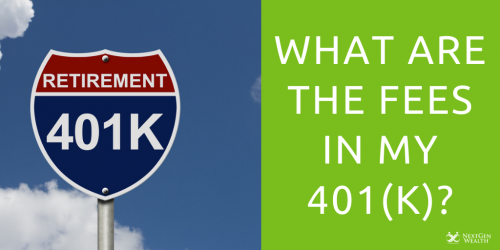What are the Fees in My 401(k)?
If you’re saving for retirement, chances are that you are putting money away into an employer-sponsored 401(k) plan. According to a recent study by the Investment Company Institute, Americans put away over $5.8 trillion in assets in 2019. By comparison, that number was only $3.1 trillion in 2010. 
While 401(k) and 403b accounts are by far the most widely utilized saving plans, you may not be aware of the various costs and fees that come with them. In fact, if you’re like 37% of savers, you may not realize that you pay anything at all.
Today, we’re going to break down the various expenses that can come with your 401(k), as well as outline different ways to minimize them if possible. The more knowledgeable you are about your money, the easier it is to plan for retirement.
What Kinds of Fees are Included With a 401(k)?
Fortunately, it is illegal to charge money for your account without notifying you first. Thanks to the Department of Labor, all investment and financial firms have to provide a document called a prospectus and plan document whenever you sign up for a 401(k). The prospectus and plan documents also have to be updated annually, including any fee adjustments that may have occurred.
Depending on the provider you have, these expenses should be easy to find within these documents. However, if you have any trouble finding them, it never hurts to ask. Generally, 401(k) fees fall into one of three categories: investment, administrative, and individual service. Here’s a breakdown of each one.
Investment Fees
In case you weren’t familiar already, the primary reason to invest in a 401(k) is that your funds will be tax-deferred.
However, since you aren’t making the trades and following the market yourself, someone has to do the work. Investment fees are usually indicated as an expense ratio percentage. This means that a small portion of the assets themselves are removed annually to cover any trade-related costs.
So, if you earn 8% return and have a 1% expense ratio, your actual return is 7%. The higher the rate, the less money you get to keep in your account.
When signing up for a 401(k), you can often choose the type of investment fund you’ll have. These funds can be broken down by risk level, investment type, and management status. Here are some of the standard options you can choose.
- Mutual Funds - Rather than buying individual stocks, your money spreads across a diverse selection of companies. This tactic helps minimize your overall risk.
- ETFs - While 401(k)s don’t allow you to trade stocks, you may be able to buy ETFs. Exchange-Traded Funds are based on a particular industry, and they trade much like a stock.
Active Management vs. Passive Management
One way that your investment fees can increase is if the fund is actively managed. This means that the manager will pay attention to market trends and try to capitalize on them as much as possible. Since there is more work involved, the costs are higher.
Actively managed funds often don’t perform better than passive funds because of their increased fees. Since trading can be such a complicated practice, it’s usually best to let as much of your money work for you, rather than relying on a manager.
Administrative Fees
While your investments are handled by one group, your account is managed by another. Your 401(k) provider charges its own fees to cover various administrative costs, such as record-keeping, accounting and payroll.
These expenses may be listed as a percentage of your total assets, or it could be a flat rate. In some cases, your employer might pay these fees, but that is not very common.
As a rule, larger companies will incur smaller charges because there are more employees and assets. So, if you work for a mid to large-size business, you’ll likely pay a lot less than if you worked for a small company.
Individual Service Fees
Your 401(k) provider may offer various financial services, such as retirement planning, IRA rollovers or 401(k) loans. If you choose to take advantage of one of these services, you’ll have to pay for it. Each provider should tell you upfront what the cost will be, and most of these options are voluntary.
How Much Should I Be Paying for My 401(k)?
Because there are so many companies managing 401(k) accounts, there is a lot of discrepancy between rates and fees. On the low end, some individuals may be paying roughly 0.2 percent of their assets. On the opposite side, prices can be as high as 3-5%. Depending on who you ask, the median cost is .50 - 1%.
At first, these numbers may seem relatively small. However, they can add up significantly over time.
Let’s say that two people invested $100,000 for 30 years with an annual return of 8%. The first person only paid one percent annually, so he or she wound up with over $760,000. The second individual paid two percent, so his or her total was only roughly $574,000 over the same period.
According to the Center for American Progress, the average American who starts a 401(k) at 25 will pay over $138,000 in fees by the time retirement hits. Even a variation of a few fractions of a percentage can make a huge difference in your nest egg.
Overall, we recommend paying no more than one percent in 401(k) fees. Ideally, you would spend less than that, but that should be the limit. If you’re paying more, then you will be in for a nasty surprise later on.
How Can I Find Out How Much I’m Paying in Fees?
Ideally, you should have a detailed report of your 401(k) account, including any administrative and investment costs. We don’t count individual service fees because they are usually one-off expenses, and they are voluntary.
When looking up administrative costs, they should be itemized so that you know where your money is going. If there is just a total, be sure to ask your 401(k) provider to break down that number. There should also be a line item that shows benefits paid (i.e., investment dividends).
To calculate your administrative cost percentage, you’ll need to subtract any benefits from the expense total. Then, you divide that by the value of your account.
For example, let’s say that your account is $100,000. You received $5,000 in benefits for the year, and you paid $6,500 in collective administrative fees. Using our calculation, your total percentage would be 1.5 (6,500 - 5,000) / 100,000 = 0.015.
Based on this total, you should try to lower your fees so that they are under one percent. In some cases, however, you may not have a choice since your employer picks the provider. However, there are multiple ways to reduce your costs, as we’ll discuss in the next section.
How Can I Reduce My 401(k) Fees?
If you’re already paying less than one percent in administrative and investment costs, you shouldn’t have to make any changes. However, if you discover that your expenses are higher than one percent, you should lower them as quickly as possible. Here are some tactics to keep your 401(k) fees manageable.
Choose a Different Investment Fund
As a rule, high-risk funds are going to be more expensive. That being said, you want to weigh the pros and cons of potentially higher earnings compared with pricier fees. In most cases, it’s not worth saving a few percentage points if you can make more money overall.
The best part about this strategy is that you should be able to do it even if you can’t change your provider. Typically, employer-sponsored plans will have multiple options available for those who have different risk tolerances. Ask your provider to show you the costs and earnings potential of all mutual funds so that you can make an informed decision.
Rollover to an IRA
If your employer uses a 401(k) provider that has high expenses, you likely won’t be able to change anything. However, it might be worth it to roll your funds into an individual retirement account (IRA) instead. This way, you can find the cheapest plan while still investing your money in the market.
Best of all, you may have an IRA already, so rolling the money over should be relatively easy. If you don’t have one, now is the time to open an account. We don’t recommend this tactic, however, if you have any employer-matching contributions with a 401(k).
Since you’ll be losing out on free money, you might just have to eat the higher costs. Regardless, putting money into an IRA is always a wise choice, as it’s always good to diversify.
There are two types of IRAs available: traditional and Roth. Here is a quick overview of both.
- Traditional IRA - These funds are tax-deferred, meaning that you get to deduct contributions from your taxes in the year you make them. Then, you pay taxes once you withdraw the money in retirement.
- Roth IRA - This account is the opposite of a traditional IRA. Instead of deducting your contributions, you still have to pay taxes on them. However, when making withdrawals, all the money is tax-free, including any investment earnings (as long as you’re 59 1/2 when it happens).
Compare Rates From Other Providers (and Convince Your Employer to Switch)
Depending on where you work, you may be able to convince your employer to switch 401(k) providers. Fortunately, there are so many options out there, so you don’t have to look hard to find a potentially better deal.
Before going to your supervisor or HR department, we recommend conducting some research first. Be sure to ask about administrative fees and how they vary based on the number of participants (employees). Remember, companies with more workers will pay less because more individuals are paying these expenses i.e. economies of scale.
Another thing to consider is to talk to your co-workers about the problem. Since many individuals don’t realize how much they’re paying in fees, most of your colleagues might not be aware that there is an issue.
Once you find a better plan and get a coalition of employees, it’s much easier to get your company to switch. Otherwise, if you’re the only one bringing it up, the management team may think that you’re an outlier.
Contact NextGen Wealth Today
Because there are so many 401(k) options out there, comparing them can seem overwhelming. Instead, let us help you on your quest to find the best representation at the lowest price.
At NextGen Wealth, we can also help you manage your money so that you’re ready for retirement. No matter what stage of life you’re in right now, give us a call so that we can help point you in the right direction.



